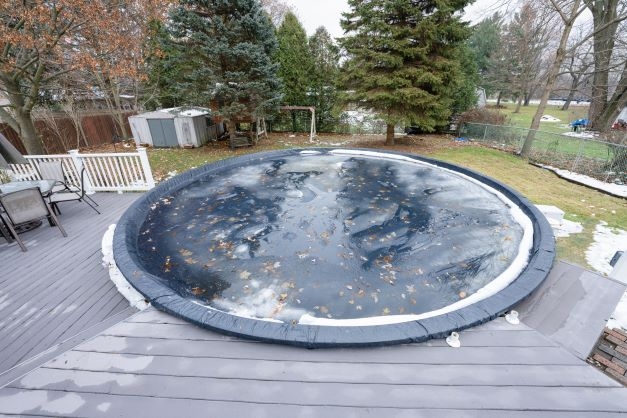When it’s too cool to swim, and you’re putting away the pool toys, it’s time to think about closing your pool. If you’re a new pool owner, you may be wondering what you need to do. How do you close a pool step by step? What chemicals do you need to close a pool? Can you leave water in an above-ground pool over the winter? Do you drain a pool in the winter instead? This guide will answer those questions and explain why winterization is important. You’ll learn how to close an inground pool with a bottom drain and how to close an above-ground pool.
Why Should I Winterize My Pool?
Winterizing your pool is important to protect it from damage and minimize maintenance for the next year. Some people mistakenly drain the pool completely instead of winterizing it. Winterizing addresses problem areas but leaves water in the pool over the winter. Leaving in the right amount of water actually helps protect the structure and liner from temperature-related damage.
What Do I Need To Winterize My Pool?
You’ll need the right winterizing chemicals, which will be covered in the next section. Also, you’ll need a drill, pool tools, and hardware. Gather these items:
- Pool skimmer
- Pool brush
- Pool vacuum and pole
- Submersible pump or siphon for inground pool
- Screwdrivers
- Socket wrenches
Pool Winterizing Chemicals
So, what chemicals do you put in a pool for winter? Using the right pool winterizing chemicals is important for preventing potential health risks and preventing pool damage. You’ll also need a water test kit. These are the pool-closing chemicals you’ll need. You’ll learn how to use them in the upcoming section with 10 steps. Be sure you have enough of the right chemicals before you start the winter pool closing process.
Pool Sanitizer
Pool sanitizer helps keep the water clean and safe from harmful bacteria. It also aids in preventing algae growth.
Pool Antifreeze
This chemical can prevent water from freezing during the winter. It’s one of the most important winter pool chemicals for preventing interior damage.
Pool pH Decreaser or Increaser
During the summer when the pool is in use, the pH should be lower. Since it won’t be in use over the winter, the pH can be higher.
Pool Algaecide
Algaecides work with chlorine to kill algae in your pool. They also promote pH balance.
Pool Shock
A shock chemical may or may not include chlorine. The purpose of it is to kill contaminants like chloramines or algae. Chloramines can irritate the eyes and respiratory system, and they can damage your pool.
How to Drain Your Pool for Winter
How to drain a pool for winter depends on the type you have. So does how far to drain it. Closing an above-ground or inground pool without draining water may be harmful. Remember that completely draining it can also be harmful. You’ll just drain enough water for proper winterization. If you are unsure how low to drain a pool for winter, these are the guidelines.
How Far to Drain an Inground Pool for Winter
Some sources say water should be an inch or two below the pool line or skimmer. Others say a few inches. As a rule, 2 inches is a good goal. Use a siphon or submersible pump to drain water.
How Far to Drain an Above-Ground Pool for Winter
Draining a pool above ground is easier. It helps to have someone measure draining progress while you drain. Four inches below the skimmer is the appropriate level to drain an above-ground pool for winter.
How to Close Above-Ground and Inground Pools for Winter in 10 Steps
Now that you know the tools, chemicals, and drain levels you need, you’re ready to get started. Most of the steps for how to close an inground pool for winter are similar to those for pools above ground. Any special type-specific steps will be noted. Before you start the steps, be sure to remove inflatable toys and other floating items.
Step 1: Clean the Pool
If you get a head start, you can add stain or scale remover during the last two weeks of use. If not, these are some important cleaning tasks to complete:
- With a skimmer, remove surface debris.
- Use a pool vacuum and pole to clean up debris.
- Scrub the sides with a pool brush.
Step 2: Test and Balance Pool Water
Use a water test kit. Remember that a higher pH in the winter is OK since the water will be sitting. For an above-ground pool, aim for a pH between 7.4 and 7.6. A winter pH level between 7.2 and 7.6 is ideal for an inground pool. Alkalinity between 80 and 120 ppm is ideal for winter. However, for inground pools, it can be as high as 150 ppm. Calcium hardness for an inground pool should be between 175 and 275 ppm. For an above-ground pool, winter calcium hardness should be 200 to 400 ppm.
Step 3: Add Pool Shock, Algaecide, and Sanitizer
In most cases, the pool shock you use should have at least 65% sodium hypochlorite. Be sure to carefully follow directions for mixing and using it. Also, make sure you have enough for the size of the pool. Pour the mixture into your pool with the filter running. Within one to three days, the chlorine level should be between 1 and 3 ppm. At that point, add your algaecide according to instructions. Add pool sanitizer as well.
Step 4: Drain the Water to an Appropriate Level
Use the guidelines discussed previously for this step. However, if you live in a climate where there is no frost, this may not be a critical step.
Step 5: Clean the Filter and Pump
For an above-ground pool, remove and clean the pump and hoses for storage. Also, take out the air filter to clean it. You can use a pool pillow to help prevent basin freezing. Add a winterizing plug instead of an inlet fitting for the winter.
If you have an inground pool, backwash the sand filter if you have one. To do this, turn off the heater and filter. Select the “drain to waste” or “backwash” setting. You may need to connect a backwash hose if you don’t have a collection receptacle. Turn on the filter for several minutes until the water is clear. Select the “rinse” setting next, run it for 30 seconds, and turn off the system.
Step 6: Blow Out the Lines
This step is for an inground pool. Residual water in the lines can cause water line cracks if it freezes. An air compressor or shop vac helps with this process. Follow your manufacturer’s instructions. After you remove all the excess water, plug the lines with an expansion plug or a threaded plug. Follow a similar process for the skimmer line, and plug it.
Step 7: Take Out Removable Fixtures
Do you have ladders, diving boards, or other accessories? If so, it’s a good idea to remove and store them.
Step 8: Add Antifreeze
Add the antifreeze to your pool according to the manufacturer’s instructions. This is especially helpful in colder climates.
Step 9: Install Your Pool Cover
Most winter pool covers are made from solid vinyl or mesh. Choose the right type and size for your needs. Follow the manufacturer’s instructions for installing it.
Step 10: Turn Off the Water and Power
If you have a power supply to your pool, turn off its breaker. Also, turn off the faucet or water shutoff valve for the pool if it has one.
What Else to Know
Many people wonder during which month they should close a pool. In most places, it’s good to do this between September and October. However, it may need to be done earlier in colder climates or later in warmer ones. Another important tip to know is to monitor the chemical composition of your pool over the winter. The pH should remain in a winter zone, and chlorine should stay between 2 and 4 ppm.
Now that you know how to close a pool, you’re ready to get to work. Find everything you need to winterize your pool at your nearest True Value store!













